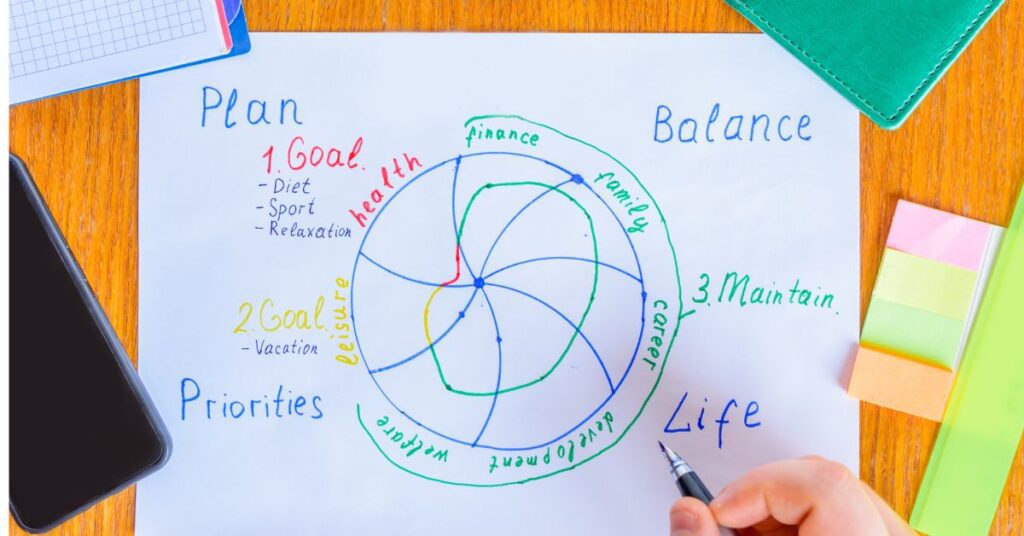Why the Life Wheel Assessment Changes Everything
The Life Wheel Assessment stands as one of the most transformative and widely-used tools in personal development, offering a visual and intuitive way to evaluate your life satisfaction across multiple crucial areas simultaneously. Unlike traditional goal-setting approaches that focus on single objectives, this comprehensive assessment reveals the interconnected nature of different life domains and helps you identify where strategic improvements can create positive ripple effects throughout your entire life experience.
Originally developed by life coaches and adapted from business management tools, the Life Wheel Assessment has helped millions of people gain clarity about their current life situation, identify priority areas for improvement, and create balanced approaches to personal growth that honor the complexity of modern life. This powerful visual tool transforms abstract feelings about life satisfaction into concrete, actionable insights that guide effective decision-making and goal-setting.
What makes the Life Wheel Assessment particularly valuable is its ability to reveal patterns and connections that might not be obvious when examining life areas in isolation. You might discover that low satisfaction in your health area is directly impacting your career performance, or that challenges in relationships are affecting your overall sense of purpose and contribution. These insights become the foundation for strategic personal development that addresses root causes rather than just symptoms.
This comprehensive guide will take you through every aspect of conducting, interpreting, and applying your Life Wheel Assessment, complete with real-world examples, advanced techniques, and practical strategies for using your results to create meaningful positive change in your life.
Table of Contents

Understanding the Life Wheel Assessment Framework
The Eight Core Life Areas
The traditional Life Wheel Assessment evaluates satisfaction across eight fundamental life areas that research has shown to be essential for overall well-being and life satisfaction. Each area represents a crucial aspect of human experience that contributes to your sense of fulfillment, purpose, and happiness.
Career and Professional Development This area encompasses your work satisfaction, professional growth, skill development, and alignment between your career and your values and aspirations. It includes not only your current job satisfaction but also your sense of progress toward meaningful professional goals and your feeling of contribution through your work.
Financial Security and Abundance Beyond just income level, this area evaluates your overall relationship with money, including financial security, debt management, savings and investment progress, and your sense of abundance versus scarcity. It also includes your confidence in your ability to meet current and future financial needs.
Health and Physical Vitality This encompasses your physical health, energy levels, fitness, nutrition habits, sleep quality, and overall vitality. It includes both your current health status and your trajectory based on your lifestyle choices, as well as your relationship with your physical body and self-care practices.
Relationships and Social Connections This area evaluates the quality of your relationships with family, friends, romantic partners, and colleagues. It includes your sense of connection, intimacy, support, and community, as well as your communication skills and ability to maintain healthy boundaries in relationships.
Personal Growth and Learning This encompasses your commitment to ongoing learning, skill development, self-awareness, and personal evolution. It includes formal education, reading, workshops, therapy, coaching, and any activities that expand your knowledge, capabilities, or understanding of yourself and the world.
Recreation and Life Enjoyment This area focuses on fun, play, hobbies, creative expression, and activities that bring you joy and help you feel most like yourself. It includes your ability to relax, have fun, pursue interests outside of work, and maintain a sense of lightness and enjoyment in your daily life.
Physical Environment and Home This encompasses your living space, work environment, and the physical spaces where you spend your time. It includes organization, aesthetics, functionality, and how well your environment supports your goals and reflects your values and personality.
Contribution and Service to Others This area evaluates your sense of making a positive difference in the world, whether through your work, volunteer activities, parenting, mentoring, or other forms of service. It includes your feeling of purpose beyond personal satisfaction and your contribution to causes or communities you care about.
Step-by-Step Life Wheel Assessment Process
Preparation Phase
Creating the Right Environment Choose a quiet time and space where you can reflect honestly without distractions. This assessment works best when you can access your authentic feelings rather than what you think you should feel or what others might expect. Consider doing this assessment when you’re in a relatively neutral emotional state rather than during particularly high or low periods.
Gathering Reflection Materials Have paper and colored pens or pencils available for creating your visual wheel. Some people prefer to use digital tools, but the physical act of drawing often enhances the reflective process and makes the results more memorable and impactful.
Setting Your Intention Before beginning, clarify your intention for completing this assessment. Are you looking for general life balance insights, trying to understand why you feel stuck, preparing for major life decisions, or seeking clarity about where to focus your personal development efforts? Your intention will guide how you approach and interpret your results.
The Assessment Process
Step 1: Create Your Life Wheel Template Draw a large circle (at least 6 inches in diameter) and divide it into eight equal sections, like slices of a pie. Label each section clearly with one of the eight life areas. Make sure each section is large enough to write notes and mark your satisfaction score clearly.
Step 2: Define Your Personal Criteria Before rating each area, spend a few minutes defining what satisfaction means to you in that specific area. For example, in the career area, satisfaction might mean feeling challenged and valued, having growth opportunities, and working in alignment with your values. In relationships, it might mean feeling deeply connected, supported, and able to be authentic with the important people in your life.
Step 3: Rate Each Area Honestly For each life area, rate your current level of satisfaction on a scale from 1 to 10, where:
•1-2: Extremely dissatisfied, major problems or neglect
•3-4: Significantly dissatisfied, important needs not being met
•5-6: Moderately satisfied, some needs met but room for improvement
•7-8: Generally satisfied, most needs met with minor areas for growth
•9-10: Highly satisfied, thriving and fulfilled in this area
Take your time with each rating and trust your initial instincts rather than overthinking. The goal is to capture your authentic current experience rather than where you think you should be or where you hope to be in the future.
Step 4: Mark Your Scores Visually Starting from the center of the circle (representing 0), mark your satisfaction score for each area along the radius of that section. For a score of 7, mark a point 70% of the way from center to edge. Use different colors for different score ranges if desired (red for 1-4, yellow for 5-7, green for 8-10).
Step 5: Connect the Dots Draw lines connecting all your marked points to create a new shape within the circle. This shape represents your current life balance and will likely be irregular rather than a perfect circle. The more irregular the shape, the more imbalanced your current life satisfaction.

Real-World Life Wheel Assessment Examples
Example 1: Sarah, Marketing Manager (Age 32)
Sarah’s Scores:
•Career: 8 (loves her work, good growth opportunities)
•Financial: 6 (decent salary but wants to save more)
•Health: 4 (stressed, poor sleep, no exercise routine)
•Relationships: 7 (good friends, dating but not serious)
•Personal Growth: 5 (reads occasionally, wants to learn more)
•Recreation: 3 (works too much, little time for hobbies)
•Environment: 8 (loves her apartment, well-organized)
•Contribution: 4 (wants to volunteer but no time)
Sarah’s Pattern Analysis: Sarah’s wheel shows a classic “workaholic” pattern with high career satisfaction but neglected health, recreation, and contribution areas. Her low health score (4) is likely contributing to stress that affects other areas. The high career and environment scores show she has strengths in creating success and organization that could be applied to other areas.
Sarah’s Action Priorities:
1.Health (Priority 1): Start with small, manageable health habits that fit her busy schedule
2.Recreation (Priority 2): Schedule specific time for enjoyable activities to prevent burnout
3.Contribution (Priority 3): Find ways to contribute through her existing work or skills

Example 2: Michael, Recent Retiree (Age 65)
Michael’s Scores:
•Career: 3 (struggling with retirement transition, loss of identity)
•Financial: 8 (good retirement savings, financially secure)
•Health: 6 (generally good but declining energy)
•Relationships: 9 (strong marriage, close family relationships)
•Personal Growth: 7 (reading more, taking classes)
•Recreation: 5 (some hobbies but looking for more purpose)
•Environment: 7 (comfortable home, considering downsizing)
•Contribution: 4 (wants to give back but unsure how)
Michael’s Pattern Analysis: Michael’s wheel shows the common retirement challenge of losing career identity while having strong relationships and financial security. His high relationship score (9) and good personal growth (7) provide a foundation for addressing the career transition and contribution gaps.
Michael’s Action Priorities:
1.Career Transition (Priority 1): Redefine identity and purpose beyond traditional career
2.Contribution (Priority 2): Explore volunteer opportunities that use his skills and experience
3.Recreation (Priority 3): Develop more engaging hobbies or activities that provide structure

Example 3: Jennifer, Single Mother (Age 28)
Jennifer’s Scores:
•Career: 5 (stable job but not passionate, limited advancement)
•Financial: 3 (struggling with single income, childcare costs)
•Health: 4 (exhausted, stress eating, no time for self-care)
•Relationships: 6 (close with family, limited social life)
•Personal Growth: 2 (no time or energy for learning)
•Recreation: 2 (no time for personal interests)
•Environment: 5 (functional but cluttered, wants better space)
•Contribution: 8 (feels fulfilled helping her child grow)
Jennifer’s Pattern Analysis: Jennifer’s wheel shows the common single parent challenge of high contribution through parenting but depleted personal resources. Her low scores in personal growth (2) and recreation (2) indicate she’s giving everything to others with little left for herself. The moderate relationship score (6) suggests some support but room for more.
Jennifer’s Action Priorities:
1.Financial (Priority 1): Explore ways to increase income or reduce expenses
2.Health (Priority 2): Find small, sustainable self-care practices
3.Support Systems (Priority 3): Build more support to create time for personal needs

Advanced Life Wheel Assessment Techniques
Customizing Your Life Wheel Categories
While the eight traditional categories work well for most people, you may want to customize your wheel to better reflect your unique circumstances, values, or life stage.
Life Stage Adaptations:
•Students: Replace “Career” with “Academic Performance” and add “Future Planning”
•New Parents: Add “Parenting” as a separate category from general relationships
•Entrepreneurs: Split “Career” into “Business Development” and “Work-Life Balance”
•Retirees: Replace “Career” with “Purpose and Meaning” or “Legacy Building”
Values-Based Customizations:
•Spiritually-oriented individuals: Add “Spiritual Growth” or “Connection to Higher Purpose”
•Creative professionals: Include “Creative Expression” as a distinct category
•Community-focused people: Separate “Community Involvement” from general contribution
•Adventure seekers: Add “Adventure and Travel” alongside recreation
The Time-Based Life Wheel Assessment
Past-Present-Future Analysis Create three separate wheels representing:
1.Past Wheel: Your life satisfaction 1-2 years ago
2.Present Wheel: Your current satisfaction levels
3.Future Wheel: Where you want to be in 1-2 years
This temporal analysis reveals trends, progress, and helps you set realistic future goals based on your historical patterns of change.
Seasonal Life Wheel Assessment Some people find their life satisfaction varies significantly with seasons, work cycles, or other temporal patterns. Consider completing quarterly assessments to identify these patterns and plan accordingly.
The Weighted Life Wheel Assessment
Importance vs. Satisfaction Matrix For each life area, rate both your current satisfaction (1-10) and the importance of that area to your overall life fulfillment (1-10). This creates a more nuanced analysis:
•High Importance, Low Satisfaction: Urgent priority areas
•High Importance, High Satisfaction: Maintain and protect these areas
•Low Importance, Low Satisfaction: Lower priority for improvement
•Low Importance, High Satisfaction: Potential areas to reduce focus
The Interconnection Analysis
Relationship Mapping After completing your basic assessment, analyze how different areas influence each other:
1.Draw connection lines between areas that significantly impact each other
2.Identify keystone areas that influence multiple other areas
3.Look for cascade effects where improvement in one area would naturally improve others
4.Find constraint areas where problems in one area limit progress in others
For example, you might discover that improving your health (keystone area) would naturally boost your career performance, recreation enjoyment, and relationship quality.

Interpreting Your Life Wheel Assessment Results
Pattern Recognition and Analysis
The Balanced Wheel Pattern If your wheel shows relatively even scores across all areas (within 2-3 points of each other), you likely have good life balance but may be playing it safe or not fully developing your potential in any particular area. Consider whether you want to maintain this balance or focus more intensively on areas that could create breakthrough results.
The Spiky Wheel Pattern Large variations between areas (some 8-10, others 2-4) indicate significant imbalances that may be creating stress or limiting your overall life satisfaction. High-scoring areas often represent strengths you can leverage to improve lower-scoring areas.
The Deflated Wheel Pattern If most areas score below 6, you may be experiencing depression, burnout, or a major life transition that’s affecting multiple areas simultaneously. This pattern often calls for professional support and a gentle, gradual approach to improvement.
The Climbing Wheel Pattern When comparing past and present wheels, an overall upward trend across most areas indicates effective personal development and life management. Celebrate this progress while identifying areas that still need attention.
Identifying Root Causes vs. Symptoms
Primary vs. Secondary Issues Some low-scoring areas may be symptoms of problems in other areas rather than primary issues themselves. For example:
•Low recreation scores might stem from financial stress or health problems
•Poor relationship scores could result from low self-esteem or unresolved personal issues
•Career dissatisfaction might reflect misaligned values rather than job-specific problems
The Constraint Theory Application Identify which area, if significantly improved, would have the most positive impact on other areas. This “constraint” area often deserves priority attention even if it’s not your lowest-scoring area.
Setting Improvement Priorities
The 80/20 Principle for Life Balance Focus on the 20% of changes that will create 80% of the improvement in your overall life satisfaction. This often means:
•Addressing one or two keystone areas rather than trying to improve everything
•Building on existing strengths rather than only fixing weaknesses
•Making changes that align with your core values and natural tendencies
The Minimum Viable Progress Approach Instead of trying to move every area to a 10, focus on bringing your lowest areas up to a 6 or 7. This creates more balance and often has a greater impact on overall life satisfaction than perfecting already-strong areas.
Creating Your Life Wheel Assessment Action Plan
Short-Term Improvements (1-3 months)
Quick Wins Strategy Identify changes that can be implemented immediately and will show results quickly:
•Health: Start a 10-minute daily walk or improve sleep hygiene
•Environment: Declutter one room or organize your workspace
•Recreation: Schedule one enjoyable activity per week
•Relationships: Reach out to one friend or family member weekly
Habit Stacking for Life Balance Connect new life balance habits to existing routines:
•Practice gratitude while drinking morning coffee (personal growth)
•Listen to educational podcasts during commute (learning)
•Do stretches while watching TV (health)
•Call a friend during weekly grocery shopping (relationships)
Medium-Term Development (3-12 months)
Skill Building Projects Identify skills that would improve multiple life areas:
•Communication skills: Improve relationships and career prospects
•Time management: Create space for health, recreation, and personal growth
•Financial literacy: Reduce money stress and increase security
•Emotional regulation: Enhance relationships and reduce stress
System and Structure Changes Implement systems that support ongoing balance:
•Weekly planning sessions that allocate time to all life areas
•Monthly life wheel check-ins to track progress and adjust focus
•Quarterly goal reviews that ensure balance across areas
•Annual life vision updates that reflect your evolving priorities
Long-Term Vision (1-3 years)
Life Integration Goals Work toward integrating different life areas so they support rather than compete with each other:
•Career alignment: Find work that reflects your values and contributes to your sense of purpose
•Relationship synergy: Build relationships that support your growth and goals
•Health integration: Make healthy choices that enhance rather than detract from other life areas
•Financial freedom: Achieve financial security that supports your other life priorities
Legacy and Contribution Planning As your life wheel becomes more balanced, focus on how your growth can benefit others:
•Mentoring others in areas where you’ve achieved satisfaction
•Contributing to causes that align with your values and experiences
•Sharing your knowledge through teaching, writing, or speaking
•Building something lasting that reflects your unique gifts and perspective
Maintaining Your Life Wheel Assessment Practice
Regular Review and Updates
Monthly Mini-Assessments Conduct abbreviated assessments focusing on your priority areas:
•Rate only the 3-4 areas you’re actively working to improve
•Note any significant changes or insights
•Adjust your action plans based on what you’re learning
•Celebrate progress and acknowledge challenges
Quarterly Comprehensive Reviews Every three months, complete a full life wheel assessment:
•Compare results to previous quarters to identify trends
•Analyze what strategies have been most effective
•Adjust your priorities based on changing circumstances
•Set intentions for the upcoming quarter
Annual Life Wheel Evolution Once yearly, conduct a comprehensive review that includes:
•Comparing your current wheel to the previous year
•Updating your life area definitions based on your growth
•Revising your priorities and goals for the coming year
•Celebrating your progress and acknowledging your journey

Integration with Other Personal Development Tools
The Life Wheel Assessment works most effectively when integrated with other personal development practices and tools. For a comprehensive approach to using your life wheel insights to create sustainable positive change, explore our complete guide on starting your self-improvement journey.
Your life wheel results provide the foundation for understanding where you are, while a structured development plan helps you create consistent progress toward greater balance and satisfaction across all areas of your life.
Sharing and Accountability
Partner Assessments Consider completing life wheel assessments with your spouse, close friend, or accountability partner. Sharing your results and supporting each other’s growth creates mutual accountability and deeper relationships.
Professional Guidance If your life wheel reveals significant imbalances or you’re struggling to create positive change, consider working with a life coach, therapist, or counselor who can provide personalized guidance and support.
Community Support Join or create groups focused on life balance and personal development. Sharing your life wheel journey with others who are committed to growth provides encouragement, ideas, and accountability.
Your Life Wheel Assessment as a Compass for Growth
The Life Wheel Assessment serves as a powerful compass for navigating the complexity of modern life, providing clear visual feedback about your current situation and guiding your decisions about where to focus your energy and attention. Unlike rigid goal-setting approaches that can create tunnel vision, the life wheel maintains awareness of the interconnected nature of different life areas and helps you create sustainable growth that honors your whole life experience.
Remember that the goal is not to achieve perfect 10s in every area, but rather to create a life that feels balanced, authentic, and aligned with your values and priorities. Your ideal life wheel shape may be different from others’, reflecting your unique circumstances, values, and life stage.
The insights you gain from regular life wheel assessments become increasingly valuable over time as you develop a deeper understanding of your patterns, preferences, and what truly contributes to your sense of fulfillment and well-being. This self-knowledge becomes the foundation for making wise decisions about career changes, relationship choices, lifestyle adjustments, and personal development priorities.
Your commitment to regularly assessing and consciously improving your life balance not only serves your own growth and happiness but also enhances your ability to contribute meaningfully to the lives of others. As you develop greater balance and satisfaction across all areas of your life, you naturally become a more present, capable, and inspiring presence in your relationships and community.
Embrace the Life Wheel Assessment as an ongoing practice rather than a one-time exercise. Let it guide you toward a life that reflects your deepest values, utilizes your unique strengths, and creates the kind of positive impact you want to have in the world.
Enjoyed this content? Read more on our website.
Life Wheel Assessment Templates and Worksheets
Basic Life Wheel Template
Instructions for Creating Your Wheel:
1.Draw a circle approximately 6-8 inches in diameter
2.Divide into 8 equal sections (45 degrees each)
3.Label each section with one life area
4.Mark the center as 0 and the outer edge as 10
5.Rate each area and mark your score along the radius
6.Connect all points to see your life balance shape
Standard Life Areas:
•Career and Professional Development
•Financial Security and Abundance
•Health and Physical Vitality
•Relationships and Social Connections
•Personal Growth and Learning
•Recreation and Life Enjoyment
•Physical Environment and Home
•Contribution and Service to Others
Customized Life Wheel Variations
Student Life Wheel:
•Academic Performance
•Financial Management
•Health and Wellness
•Social Relationships
•Personal Development
•Recreation and Hobbies
•Living Environment
•Future Planning
Entrepreneur Life Wheel:
•Business Development
•Financial Management
•Health and Energy
•Relationships and Networking
•Skill Development
•Work-Life Balance
•Physical Environment
•Impact and Legacy
Parent Life Wheel:
•Career Satisfaction
•Financial Security
•Personal Health
•Parenting Fulfillment
•Adult Relationships
•Personal Growth
•Home Environment
•Community Contribution
Assessment Reflection Questions
For Each Life Area, Consider:
•What does satisfaction in this area mean to me specifically?
•What evidence do I have for my current rating?
•What would need to change for me to rate this area one point higher?
•How does this area influence or connect to other areas of my life?
•What strengths from other areas could I apply here?
Overall Pattern Analysis:
•What patterns do I notice in my wheel shape?
•Which areas seem to influence multiple other areas?
•Where do I see the biggest gaps between importance and satisfaction?
•What would my ideal wheel look like in 12 months?
•What themes emerge when I look at my highest and lowest scoring areas?
Action Planning Worksheet
Priority Area Selection:
1.Urgent (Low satisfaction, high importance): ________________
2.Important (Medium satisfaction, high importance): ________________
3.Opportunity (High potential for positive ripple effects): ________________
For Each Priority Area:
Current State: What specifically makes this area unsatisfying? Desired State: What would this area look like at a higher satisfaction level? First Steps: What are 3 small actions I could take this week? Resources Needed: What support, skills, or resources would help? Success Metrics: How will I know I’m making progress? Timeline: What’s a realistic timeframe for meaningful improvement?
Progress Tracking Tools
Monthly Check-In Template:
•Date: ___________
•Areas of Focus This Month: ________________
•Biggest Win: ________________
•Main Challenge: ________________
•Insights Gained: ________________
•Adjustments for Next Month: ________________
Quarterly Review Template:
•Quarter: ___________
•Life Wheel Scores Comparison:
•Area 1: Previous _____ Current _____ Change _____
•Area 2: Previous _____ Current _____ Change _____
•[Continue for all areas]
•Most Improved Area: ________________
•Area Needing More Attention: ________________
•Key Lessons Learned: ________________
•Priorities for Next Quarter: ________________
References
Whitworth, Laura, et al. “Co-Active Coaching: Changing Business, Transforming Lives.” Nicholas Brealey Publishing, 2007.
Covey, Stephen R. “The 7 Habits of Highly Effective People.” Free Press, 1989. https://www.franklincovey.com/
Seligman, Martin E.P. “Flourish: A Visionary New Understanding of Happiness and Well-being.” Free Press, 2011. https://www.authentichappiness.sas.upenn.edu/
Brown, Brené. “The Gifts of Imperfection.” Hazelden Publishing, 2010.
Clear, James. “Atomic Habits: An Easy & Proven Way to Build Good Habits & Break Bad Ones.” Avery, 2018.
